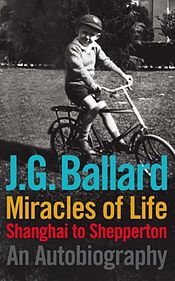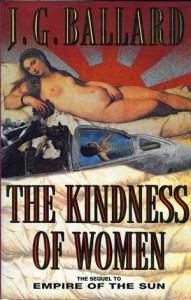Miracles of Life: Shanghai to Shepperton: An Autobiography
J. G. Ballard
Fourth Estate, 2008
In his peak writing years, those three decades between The Drowned World (1962) and The Kindness of Women (1991), J. G. Ballard was a writer who seldom failed to surprise. During his final decade of writing fiction, however, stretching from Cocaine Nights (1996) to Kingdom Come (2006), which bracketed Super-Cannes (2000) and Millennium People (2003), he seemed to be writing virtually the same book over and over again, retaining essentially the same cast of characters (but changing the names) and slightly altering the settings from vaguely fascistic suburban resort enclaves along the Mediterranean coast to vaguely fascistic English suburbs and shopping malls. Like Beethoven with his 33 Variations on a Waltz by Anton Diabelli, Ballard, with his final quartet of novels, obsessively pursued variations on a theme, far more narrowly than he had earlier in his career.
Yet, with the last book he completed prior to his death in 2009, Miracles of Life, Ballard managed to spring a final surprise on his reading public. Word that the writer was working on his autobiography raised excited anticipation – so much of Ballard’s fiction had either been heavily autobiographical (Empire of the Sun [1984] and The Kindness of Women) or fantastically extrapolated from incidents in his life (Crash [1973] and The Unlimited Dream Company [1979]), that his readers (this reader certainly included) could hardly wait to have the wizard pull aside the curtain and reveal, once and for all, which elements of his fictions had been based on his life experiences and which had been fully imagined.
The final surprise this prodigiously talented writer, with his unique voice and viewpoint, managed to spring was that he wrote such an unrevealing, limp, and therefore superfluous autobiography as his last testament. The scanty revelations the book contains could have been assembled into a medium-length magazine article. We do learn a good bit about his parents, who, as characters, remained mostly off-stage (for novelistic reasons) in Empire of the Sun. We learn that he met his wife, Mary, at a party given by fellow science fiction writers and fans, members of the circle surrounding New Worlds, not long after he started publishing his earliest stories in that magazine. We are also granted a fairly detailed portrait of Ballard’s long friendship with fellow writer Kingsley Amis (father of Martin), author of such post-war English classics as Lucky Jim, as well as an amusing anecdote regarding a lunch with the publisher of The Drowned World, Victor Gollancz, who assumed out loud that Ballard had cribbed his novel from Heart of Darkness (when Ballard hadn’t yet read a word of Joseph Conrad’s).
So the book has its pleasures. Yet, for any readers who are familiar with Empire of the Sun, based on Ballard’s childhood years in Shanghai and the Lunghua camp run by the Japanese military, and The Kindness of Women, based on his life from the last days of World War Two through the filming of Steven Spielberg’s movie version of Empire of the Sun in 1987, Miracles of Life will come as a repetitive, mostly airless reading experience. This is because, with the exceptions I’ve listed above, Ballard’s autobiography repeats the sequences of events in his two earlier novels, but in much less vividly described fashion.
When I recently read the autobiography, I hadn’t read either of the novels since they had first appeared in the U.S., twenty-eight and twenty-one years ago. Intrigued by many of the autobiography’s somewhat sketchy portraits of his friends and intimates during his years living in Shepperton, I decided to reread The Kindness of Women immediately afterward. I was very surprised – on the verge of shocked – to find that whole passages had been transposed, either verbatim or close to it, from the earlier novel to the autobiography. Ballard had plagiarized himself. Passages of The Kindness of Women which reappear in Miracles of Life include descriptions of Ballard’s service in the Royal Air Force, receiving flight training in rural Canada, and descriptions of his instigation of an art installation of crashed cars and his subsequent personal car crash, prior to the publication of Crash. The description of the filming of Shanghai-set scenes of Empire of the Sun in a suburban neighborhood adjoining Shepperton in Kindness is also repeated nearly verbatim in Miracles.
The autobiography also suffers from a lack of detail on matters not directly addressed in the two semi-autobiographical novels. Readers get very little sense of the personalities of Ballard’s wife Mary or his partner of forty years, Claire Bloom, and his three children are cyphers, not individualized at all (although he does spend a good deal of the book speaking to how grateful he was for their presence in his life). Particularly disappointing to science fiction fans (in The Kindness of Women, the Ballard-figure protagonist is not identified as having any connection with the literature of science fiction at all) has to be the author’s very sketchy portrayal of his most important and long-lasting friendship in the science fiction world, that with Michael Moorcock. Moorcock and Ballard were central to British participation in science fiction’s New Wave, and their friendship and collaboration thus has a good bit of historical interest attached. How sad, then, that this relationship is given such short shrift in Miracles of Life. I suppose we must now depend upon Michael Moorcock to provide a fuller picture, should he ever choose to do so.
Why did Ballard choose to write Miracles of Life during his last year, considering that, at best, it merely recapitulates scenarios previously (and far more vividly) described in Empire of the Sun and The Kindness of Women, offering very little in the way of additional insight into the famed writer? I can postulate as to a few possible motivations. Having been diagnosed with severe prostate cancer, he may have wanted to set out for himself a fresh project to devote his remaining energies to, a goal which would give him reason to continue getting out of his sick bed each morning; perhaps another novel was not forthcoming, and a career-capping autobiography seemed the only alternative. Knowing that interest in such an autobiography would be fairly high (although the book has yet to find an American publisher), he may have wanted to provide a final boost to the monetary inheritance he would provide for Claire Booth and his children. A third motive? Over the prior decade, Ballard had shown a proclivity towards playing variations on a theme. Perhaps Miracles of Life was a continuation of this proclivity, a (slight) variation on the themes he had already expressed in his two semi-autobiographical novels.
With Ballard having died a year after his writing of his autobiography, we will never know his actual motivation for what on the surface seems an odd choice for a project to cap his luminous career.
I’ve also written about J. G. Ballard’s works elsewhere:
It’s J. G. Ballard’s World, We Just Live in It
The Thrill of the New: The Drowned World, The Drought, and The Crystal World








